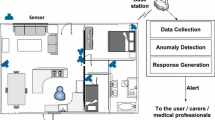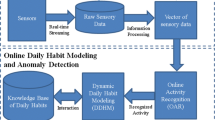Abstract
The number of elderly people requiring different levels of care in their homes has increased in recent times, with further increases expected. User studies show that the main concern of elderly people and their families is “fall detection and safe movement in the home”. We view abnormally long periods of inactivity as indicators of unsafe situations, and present a new method that models the tail of a hyperexponential distribution in order to reliably identify such inactivity periods from unintrusive sensor observations. The performance of our method was evaluated on two real-life datasets, and compared with that of a state-of-the-art technique, with our method outperforming this technique.
Access this chapter
Tax calculation will be finalised at checkout
Purchases are for personal use only
Preview
Unable to display preview. Download preview PDF.
Similar content being viewed by others
References
Celler, B., Earnshaw, W., Ilsar, E., Betbeder-Matibet, L., Harris, M., Clark, R., Hesketh, T., Lovell, N.: Remote monitoring of health status of the elderly at home – A multidisciplinary project on aging at the University of New South Wales. International Journal of Bio-Medical Computing 40(2), 147–155 (1995)
Cook, D.: Learning setting-generalized activity models for smart spaces. IEEE Intelligent Systems 27(1), 32–38 (2012)
Courtney, K., Demiris, G., Rantz, M.: Needing smart home technologies: The perspective of older adults in continuing care retirement communities. Informatics in Primary Care 16(3), 195–201 (2008)
Cuddihy, P., Weisenberg, J., Graichen, C., Ganesh, M.: Algorithm to automatically detect abnormally long periods of inactivity in a home. In: HealthNet 2007 – Proceedings of the 1st ACM International Workshop on Systems and Networking Support for Healthcare and Assisted Living Environments, San Juan, Puerto Rico, pp. 89–94 (2007)
Davies, L., Gather, U.: The identification of multiple outliers. Journal of the American Statistical Association 88(423), 782–792 (1993)
Demiris, G., Oliver, D., Dickey, G., Skubic, M., Rantz, M.: Findings from a participatory evaluation of a smart home application for older adults. Technology and Health Care 16(2), 111–118 (2008)
Eldén, L.: Algorithms for the regularization of ill-conditioned least squares problems. BIT Numerical Mathematics 17(2), 134–145 (1977)
Feldmann, A., Whitt, W.: Fitting mixtures of exponentials to long-tail distributions to analyze network performance models. Performance Evaluation, 245–279 (1998)
Izenman, A.J.: Recent developments in nonparametric density estimation. Journal of the American Statistical Association 86(413), 205–224 (1991)
Kasteren, T.L., Englebienne, G., Kröse, B.J.: An activity monitoring system for elderly care using generative and discriminative models. Personal Ubiquitous Computing 14(6), 489–498 (2010)
Larizza, M., Zukerman, I., Bohnert, F., Busija, L., Bentley, S., Russell, R., Rees, G.: In-home monitoring of older adults with vision impairment: Exploring patients’, caregivers’ and professionals’ views. Journal of the American Medical Informatics Association 21(1), 56–63 (2013)
Ljung, L.: System identification: Theory for the user, 2nd edn. Prentice Hall (1999)
Moshtaghi, M., Zukerman, I., Albrecht, D., Russell, R.A.: Monitoring personal safety by unobtrusively detecting unusual periods of inactivity. In: Carberry, S., Weibelzahl, S., Micarelli, A., Semeraro, G. (eds.) UMAP 2013. LNCS, vol. 7899, pp. 139–151. Springer, Heidelberg (2013)
Moshtaghi, M., Zukerman, I., Russell, R.A., Albrecht, D.: Towards detecting inactivity using an in-home monitoring system. In: ICIEA 2013 – Proceedings of the IEEE Conference on Industrial Electronics and Applications, Melbourne, Australia, pp. 935–940 (2013)
Nait-Charif, H., McKenna, S.: Activity summarisation and fall detection in a supportive home environment. In: ICPR 2004 – Proceedings of the 17th International Conference on Pattern Recognition, Cambridge, England, vol. 4, pp. 323–326 (2004)
Pollack, M.E.: Intelligent technology for an aging population: The use of AI to assist elders with cognitive impairment. AI Magazine 26(2), 9–24 (2005)
Riska, A., Diev, V., Smirni, E.: Efficient fitting of long-tailed data sets into hyperexponential distributions. In: GLOBECOM 2002 – Proceedings of the IEEE Global Telecommunications Conference, Taipei, Taiwan, vol. 3, pp. 2513–2517 (2002)
Sadre, R., Haverkort, B.R.: Fitting heavy-tailed HTTP traces with the new stratified EM-algorithm. In: 4th International Telecommunication Networking Workshop on QoS in Multiservice IP Networks, pp. 254–261 (2008)
Schultze, V., Pawlitschko, J.: The identification of outliers in exponential samples. Statistica Neerlandica 56(1), 41–57 (2002)
Weisenberg, J., Cuddihy, P., Rajiv, V.: Augmenting motion sensing to improve detection of periods of unusual inactivity. In: HealthNet 2008 – Proceedings of the 2nd ACM International Workshop on Systems and Networking Support for Healthcare and Assisted Living Environments, Breckenridge, Colorado, pp. 2:1–2:6 (2008)
Yu, X.: Approaches and principles of fall detection for elderly and patient. In: IEEE HealthCom 2008 – Proceedings of the International Conference on e-Health Networking, Applications and Services, Singapore, pp. 42–47 (2008)
Author information
Authors and Affiliations
Editor information
Editors and Affiliations
Rights and permissions
Copyright information
© 2014 Springer International Publishing Switzerland
About this paper
Cite this paper
Moshtaghi, M., Zukerman, I. (2014). Modeling the Tail of a Hyperexponential Distribution to Detect Abnormal Periods of Inactivity in Older Adults. In: Pham, DN., Park, SB. (eds) PRICAI 2014: Trends in Artificial Intelligence. PRICAI 2014. Lecture Notes in Computer Science(), vol 8862. Springer, Cham. https://doi.org/10.1007/978-3-319-13560-1_85
Download citation
DOI: https://doi.org/10.1007/978-3-319-13560-1_85
Publisher Name: Springer, Cham
Print ISBN: 978-3-319-13559-5
Online ISBN: 978-3-319-13560-1
eBook Packages: Computer ScienceComputer Science (R0)




